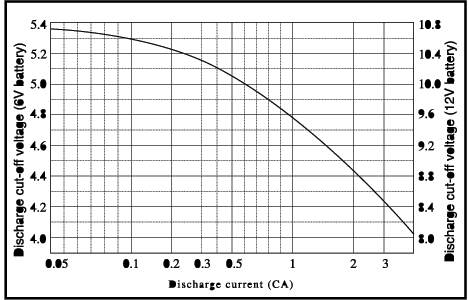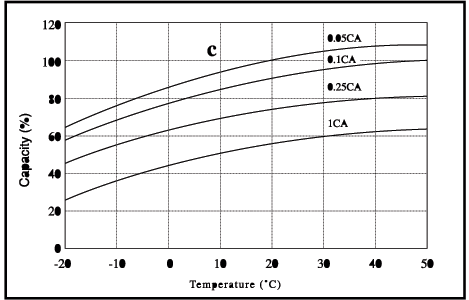|
Discharging |
|
|
(1) Discharge Current and Discharge Cut-Off Voltage
Recommended cut-off voltages for 6V and 12V batteries consistent with
discharge rates, are given in the figure below. With smaller discharging
currents, the active materials in the battery can work effectively. As a
result, the discharge cut-off voltages are set to the higher side to
control overdischarge. For larger discharge currents, on the contrary,
cut-off voltages are set to the lower side. |
|
Discharge Capactiy vs. Cut-Off Voltage |
|
 |
|
|
(2) Discharge Temperature
(a)
Control the ambient temperature during discharge within 5°F to 122°F
(-15°C to 50°C) for the reason described below.
(b) Batteries operate on the electrochemical reaction that converts
chemical energy to electric energy. The electrochemical reaction is
reduced as the temperature lowers. Therefore, available discharge
capacity is greatly reduced at temperatures as low as 5°F(-15°C). For
the high temperature side, on the other hand, the discharge temperature
should not exceed 122°F
(50°C ) in order to prevent deformation of resin mateirals that house
the battery or deterioration of service life. |
|
|
(3) Effect of Temperature on Discharge Characteristics
Available discharge capacity of the battery varies with ambient
temperature and discharge current as shown in the figure below. |
|
Discharge Capactiy by Temperature and by Discharge Current |
|
 |
|
|
(4) Discharge Current
Discharge capacity of batteries is expressed by the 20 hour rate(rated
capacity). Select the cattery for the specific equipment so that the
discharge current during use of the equipment falls between 1/20 of the
20 hour rate value and 3 times that (1/20 CA to 3 CA); Discharging
beyond this range may result in a remarkable decrease of discharge
capacity or reduction in the number of times of repeatable
discharge.When discharging the battery beyond the said range, please
consult TEMPEST in advance.
For
some types of SLA batteries with built-in thermostats, the discarge
current may be auotmatically cut off by these thermostats when above 4A
at the room temperature of 104°F (40°C). Therefore, the maximum
discharge current value should be the smaller of either 4A or 2CA. |
|
|
(5) Depth of Discharging
Depth of discharging is the state of discharge of batteries expressed by
the ratio of amount of capacity discharged to the rated capacity. |
|
|
